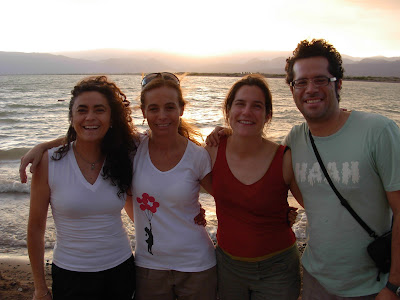De Buenos Aires nos dirigimos hacia el noreste argentino. Otro viaje de toda la noche en bus que nos dejo muy temprano en la mañana en Mercedes, una pequeña ciudad colonial en la provincia de Corrientes, en plena Mesopotamia argentina. Recorriendo sus calles buscando algun medio de transporte que nos llevara a Colonia Pellegrini, en los esteros del Ibera, teniamos la sensacion de que alli el tiempo se detuvo hace varias decadas / Von Buenos Aires reisten wir weiter gen Norden. Eine Busreise ueber Nacht entfernt erreichten wir zu frueher Morgenstunde die kleine Kolonialstadt Mercedes, wo die Zeit vor einigen Jahrzehnten stehengeblieben zu sein schien. Von dort aus suchten wir ein Gefaehrt zur Weiterreise mittags zur Colonia Pellegrini, unser eigentliches Ziel / Fromout Buenos Aires we travelled on towards the north. An overnight busride away we reached in the early morning hours the small colonial city of Mercedes, where the time seemed to have stood still since several decades. There we looked for a mean of transport to go on at midday to the Colonia Pellegrini, our real destination.
Cuando llegamos a Mercedes, antes del amanecer, nos sorprendio encontrar muchisima gente en la pequeña terminal y sus alrededores, algunos incluso en improvisados campamentos. Pensamos que serian trabajadores de estacion o algo asi... Mas tarde, cuando vagabundeamos por sus calles, la sorpresa fue mayor al encontrar gauchos por todas partes, como si todos los que no habiamos visto hasta ahora en Argentina se hubieran concentrado alli. Poco a poco fuimos descubriendo que el “gauchito Gil” tenia algo que ver con esto, y finalmente conseguimos averiguar que justo el dia anterior mas de 40 000 peregrinos se habian concentrado en el santuario del gauchito, que esta a nueve kilometros de Mercedes, para su congregacion anual. Asi que en realidad alli se habian concentrado “todos” los gauchos del pais! / Wir wunderten uns ueber die vielen Menschen, die am Busbahnhof warteten und sogar campten. Zuerst dachten wir es handelte sich um Saisonarbeiter. Beim Spaziergang durch die Stadt waren wir ganz begeistert einige richtige „gauchos“, die argentinischen Cowboys, in voller Montur zu sehen. Als wir dann die ersten kleinen Figuren erblickten, merkten wir dass der Menschenauflauf irgendetwas mit dem gauchito Gil zu tun hat und wurden aufgeklaert, dass am Vortag 40.000 Anhaenger des Gauchito Gil in seinem neun Kilometer von Mercedes entfernten Pilgerort zusammenkamen. In Mercedes waren also alle „gauchos“ Argentiniens versammelt! / We were surprised about the many people, that were waiting at the bus station, some even camping there. First we thought, these were seasonal workers. While strolling through the city, we were totally fascinated by seeing real “gauchos”, the Argentinian cowboys, totally dressed up. But when we saw the first small figures, we realized that the crowd had something to do with the “Gauchito Gil” and some people explained us, that the day before 40.000 pilgrims had gathered for the annual festival of the Gauchito Gil at his santuary nine kilometres away from Mercedes. So at this time ALL “gauchos” of Argentina came together!
La devocion por el “gauchito Gil“ no es solo de los gauchos, es muy popular en buena parte de la poblacion del pais. Aunque se trata de un personaje que vivio hace mas de 100 años, su culto se ha extendido solamente en la ultima decada. En todas las carreteras que recorrimos vimos altares dedicados a su figura (se reconocen por los pañuelos rojos que adornan el sitio), incluso en el extremo sur de la Patagonia / Die Verehrung des “Gauchito Gil” kommt nicht nur von den “gauchos”, sondern ist bei einem grossen Teil der argentinischen Bevoelkerung beliebt. Obwohl er vor mehr als hundert Jahren lebte, hat sich der Kult erst in den letzten zehn Jahren soweit ausgebreitet. Wir sahen bereits ueberall kleine Altare am Strassenrand, sogar bis im weitentfernten Patagonien. Wenn ihr also irgendwo in Argentinien einen Altar mit roter Deko seht, dann habt ihr einen Altar des „Gauchito Gil“ gesehen (Auf dem T-shirt steht „Gauchito Gil beschuetzt uns“) / The devotion to the “Gauchito Gil” includes not only “gauchos”, but is very popular with a big part of the Argentinian population. Although he lived more than 100 years ago, the cult only spread recently in the last ten years. Everywhere we had seen already little altars next to the road, even in the far other end in Patagonia. So whenever in Argentina you see an altar with red decoration, you have seen an altar for “Gauchito Gil” (The T-shirt says “The Gauchito Gil protects us”).
Conseguimos por fin un transporte que nos llevara a Colonia Pellegrini, a cuatro horas de Mercedes, en medio del parque natural Esteros del Ibera. El parque esta lleno de lagunas, terreno inundado, canales y frondosa vegetacion, donde vive una gran variedad de animales caracteristicos de este peculiar ecosistema. Estuvimos caminando en la isla de los monos, que andaban muy timidos y no se dejaron ver, pero en cambio se asomo este hermoso felino salvaje que nos permitio tocarlo. Pocos turistas vienen por aqui, y menos en esta epoca tan caliente del año! / Vier Stunden spaeter erreichten wir von Mercedes aus das 500-Seelen-Dorf Colonia Pellegrini, inmitten des Naturschutzparks der Estero del Ibera. Inmitten von Lagunen und Suempfen leben viele nur dort heimische Tiere, die man von der Kolonie aus beobachten kann. Als wir zuerst mit unserem Fuehrer ueber die „Affeninsel“ wanderten, sahen wir zwar keine Affen, aber dafuer diese Wildkatze (gato montes), die wild lebt, aber mittlerweile ganz zahm geworden ist und Streicheleinheiten suchte. Viele Touristen verirren sich nicht dorthin, zumindest nicht zu dieser heissen Jahreszeit / Four hours later we reached fromout Mercedes the small village of Colonia Pellegrini, in the middle of the Natural park Esteros del Ibera. Inmidst of lagoons and wetlands live many special animals, that you can only find there and where the colony is a great place to observe them. When we first walked over the monkey island, we didn’t see any monkeys, but instead this wild cat, living in the jungle, but that totally lost fear and is looking for caresses. Not many tourists come to the colony, at least not at this hot time of the year.
Tambien vimos a los carpinchos (o chiguiros, como se les llama en los llanos de Colombia y Venezuela), que son los roedores mas grandes del planeta. Parecen un conejillo de indias, pero claro, del tamaño de una ternera. Pasan mucho tiempo en las orillas de los rios, donde se alimentan. Como en el parque no han de temer por terminar en una cazuela, esta familia paso a menos de un metro de distancia de nosotros / “Carpinchos” heissen diese groessten Nagetiere der Welt in Argentinien, “chiguiros” in Kolumbien und sind wirklich sehr verwunderlich. Wie ein Meerschweinchen, aber so gross wie ein Wildschwein, verbringen sie viel Zeit im Wasser und sind hier in den Suempfen natuerlich in ihrem Element. Da die hier im Naturpark keine Angst haben, im Kochtopf zu landen, lief die Familie mit einem Meter Abstand an uns vorbei / These biggest rodents of the world called „Carpinchos“ in Argentina, „chiguiros“ in Colombia, really surprised us. They look like a guinea-pig, but are as big as a hog, pass most of their time in the water, why the marshlands around are just perfect. As here in the park they don’t fear to end in the pot, the family passed us by without fear and only a one meter distance.
Habeis oido alguna vez el silbido de un carpincho? Pues aqui lo teneis en esta peli... / Habt ihr schon mal ein pfeifendes “carpincho” gehoert? Dann schaut Euch den kleinen Film an / Have you already heard a whistling “carpincho”? Then have a look at this movie:
El carpincho macho, siguiendo a sus crias, paso muy cerca de nosotros / Das Carpincho-Maennchen bildete die Nachhut und lief ganz dicht an uns vorbei / The male carpincho came at last, following the offspring, and passed very close to us:
Pero en el parque los carpinchos tienen un enemigo natural, el temible yacare, pariente del cocodrilo. Son una de las grandes atracciones del parque, y se navega en bote al final de la tarde para verlos cerca de la orilla preparandose para cazar la cena / Die grosse Attraktion des Naturparks sind die “yakares”, die einheimische Krokodilart, von denen wir viele aus der Naehe vom Boot aus beobachten konnten / The big attraction of the Esteros del Ibera are the “yakares”, this kind of crocodile, whereof we could observe many fromout the boat.
En esta peli se puede ver un yacare muy de cerca! / In diesem Film koennt ihr dem Yakare selbst in die Augen schauen / In this movie you can look yourself in the eyes of the Yakare:
Asi navegamos por los esteros esa bonita tarde / So duempelten wir durch die Lagune / That way we made our way through the lagoon.
Esta isla estaba una semana atras en el otro lado de laguna. Es tipico de la zona estas “islas flotantes” que se desplazan segun los caprichos del nivel del agua en los esteros. El arbol que se refleja en el agua es llamado ”sangre de dragon“ por los guaranies de la zona, y sirve para curar heridas/ Die Insel mit diesem Baum war die vorige Woche noch auf der anderen Seite. Der Baum wird Drachenblut genannt und seine Blaetter werden von den guaranies, der einheimischen Bevoelkerung, zur besseren Vernarbung benutzt / The island with this tree was the week before still on the other side. The tree is called Dragonblood and is used by the guaranies, the locals, to heal wounds.
Mientras contemplabamos el atardecer en medio de la laguna, un yacare la atravesaba dejando una fina linea en el espejo de agua. Fue un espectaculo sublime! / Sonnenuntergang inmitten der Lagune und ein Yakare kreuzt in der Ferne und bildet eine Linie hinter sich, oh wie schoen ist Colonia Pellegrini! / Sunset in the middle of the lagoon and a yakare crossing it in the distance forming a line behind it, so beautiful!
El unico bus que hace el recorrido entre Colonia Pellegrini y Posadas, nuestro proximo destino, estaba roto. Solo quedaba esperar a que lo arreglaran o dar un largo rodeo regresando a Mercedes, lo cual hacia imposible visitar las ruinas jesuitas de San Ignacio Mini, donde tambien queriamos ir. Pero ocurrio que justo arribo un grupo de italianos que habian alquilado una camioneta para hacer la ruta completa y que ahora se dirigian a Posadas... El conductor accedio a llevarnos en la parte trasera por una “modica” suma, y en la peli podeis ver como ibamos apretados entre nuestras mochilas y las de los italianos (que iban comodamente sentados en la segunda cabina de la camioneta, con aire acondicionado), la rueda de repuesto, un bidon de gasolina por si las moscas, y algunas cositas mas. Cada tanto teniamos que cambiar de posicion para que no se durmiera una pierna o un brazo, pero aun asi yo logre dormir un buen rato como se puede ver. Tal vez ayudo el vapor de la gasolina... / Der normale Bus nach Posadas von Colonia Pellegrini aus war kaputt. Damit waeren wir nur ueber Mercedes ueber einen mehrtaegigen Umweg weitergekommen und die Ruinen von San Ignacio Mini flachgefallen. Aber ein gluecklicher Zufall wollte, dass an dem Tag ein paar Italiener als Tagesausflug von Posadas aus zur Kolonie kamen, und der Fahrer uns fuer etwas Geld hinten im Gepaeckraum mitnahm. Wir quetschten uns als blinde Passagiere hinten zwischen unsere Rucksaecke, das Ersatzrad und den stinkenden Benzinkanister und wechselten immer mal die Position. Dass Ricardo bei dem Rumpeln schlafen konnte, kann ich mir nur mit den Daempfen des Benzinkanisters erklaeren / The normal bus from Colonia Pellegrini to Posadas was broken. Therefore the only way to travel on was back via Mercedes and a detour of several days and making the visit of the ruins of San Ignacio Mini impossible. But a lucky coincidence was that just that day an Italian group came on a day excursion to the colony and the driver agreed to take us for some money in the rear of his jeep to Posadas. In the movie you can see how we travelled squeezed in between our rucksacks, the spare wheel and a gasoline can, changing our positions from time to time. That Ricardo was able to sleep in that situation, maybe has its explanation in the vapors of the stinking gasoline can:
Estupendo marco colonial de la plaza 9 de julio en Posadas / Ein schoenes Kolonialhaus in Posadas am Plaza 9 de Julio / A nice colonial house in Posadas at the Plaza 9 de Julio
Para ver este anuncio de la radio Venus en Mercedes, mas gauchos, animales y naturaleza, podeis hacer click en la foto inferior para acceder al Web Album: / Um das Schild von Radio Venus in Mercedes, mehr gauchos, Tiere und Natur zu sehen, klickt einfach auf das Bild hier drunter zum Web Album / To see the sign of Radio Venus in Mercedes, more gauchos, animals and nature, just click on the icon below and you get to the Web Album:
 |
| Mercedes Colonia Pellegrini |





















































